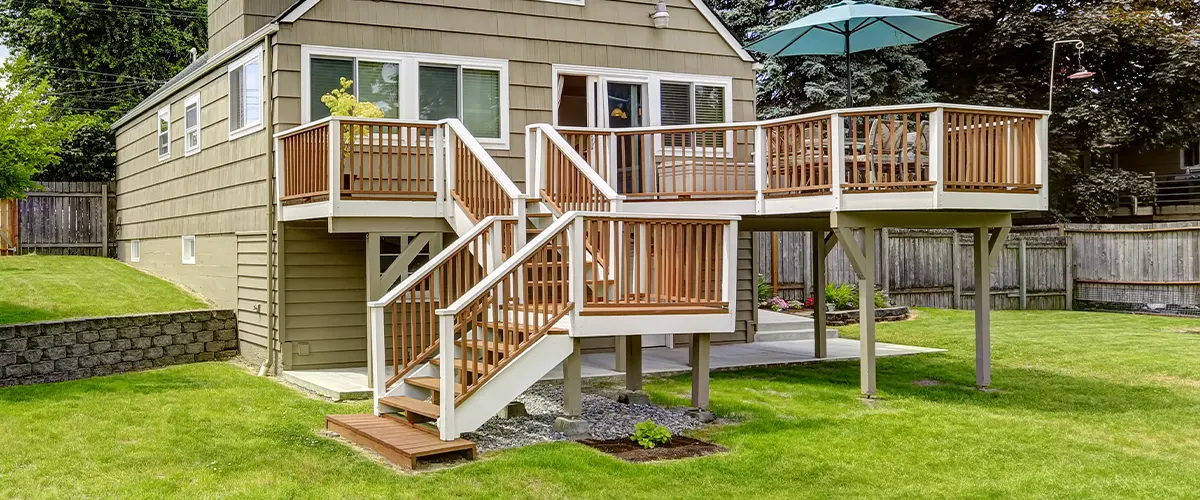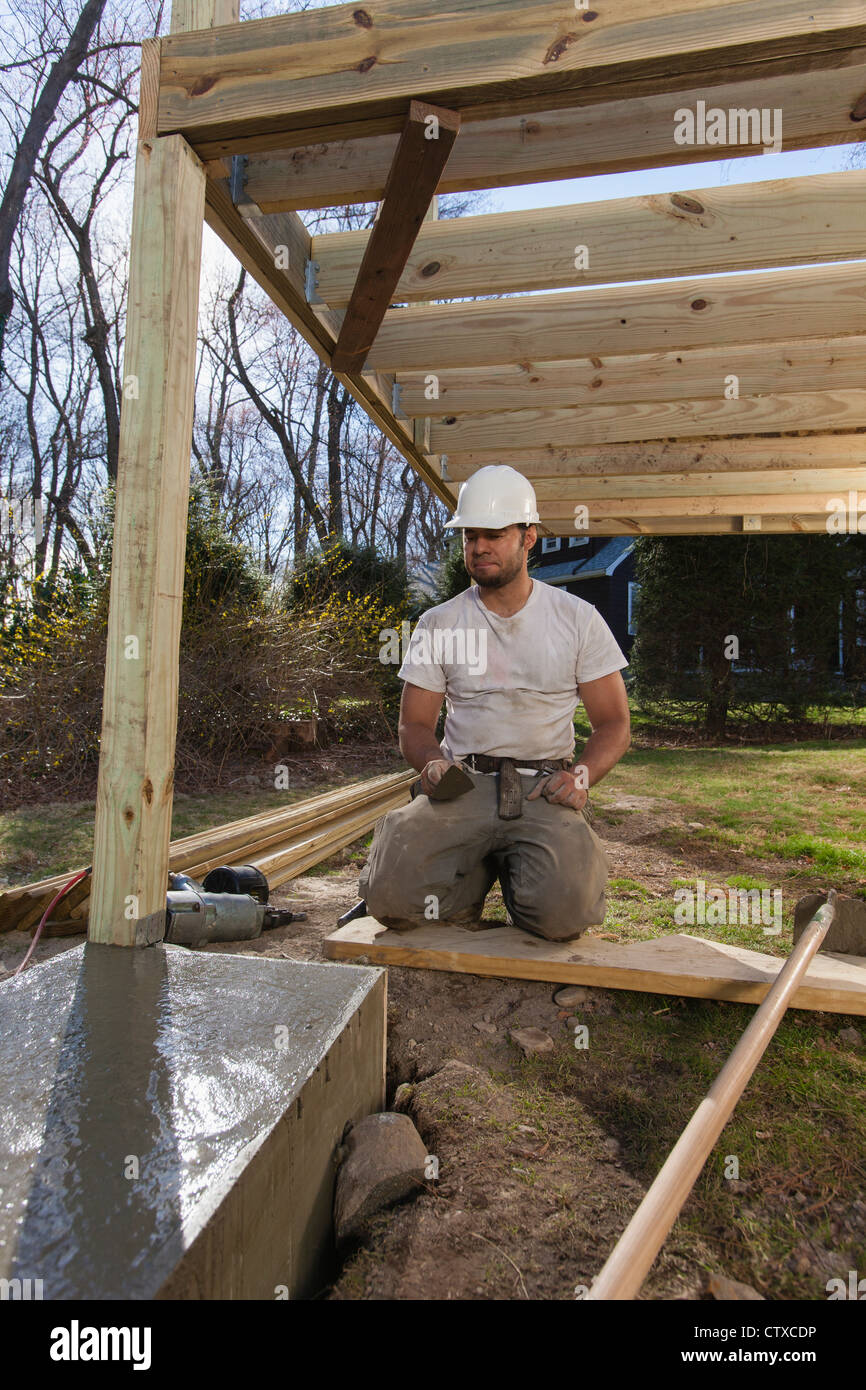Deck Footings Revealed: Recognizing the Key Parts of a Dependable Deck Framework
Wiki Article
Ensure Security and Longevity With Properly Mounted Deck Grounds
Deck footings may not be the most glamorous aspect of deck construction, however they play a vital role in guaranteeing security and longevity. Properly set up grounds offer a strong foundation for your deck, avoiding common problems like sagging, shifting, and even collapse. However, selecting the best kind of footing and properly mounting it can be an intricate procedure. In this discussion, we will certainly discover the importance of correct deck grounds, elements to take into consideration during installment, different kinds of grounds readily available, step-by-step installation overview, and upkeep tips for making sure resilient footings. So, if you wish to guarantee the stability and long life of your deck, maintain checking out to find the crucial understandings to achieve a resilient and structurally sound exterior space.
Value of Correct Deck Grounds
Why are properly set up deck grounds critical for the stability and longevity of your deck? The solution lies in the fundamental function that deck footings play in supporting the weight of the entire framework. Deck footings are the structure on which the deck rests, transferring the lots from the deck to the ground. It can lead to a range of issues that endanger the stability and longevity of the deck. when footings are not correctly set up.Firstly, effectively set up deck grounds distribute the weight of the deck evenly, avoiding any uneven settling or sinking. This is particularly essential in locations with unpredictable dirt, as it aids to reduce the risk of the deck breaking down or shifting. In addition, well-installed grounds ensure that the deck remains level, stopping any type of structural damages that can occur when a deck ends up being uneven.
Secondly, properly installed footings give a strong support for the deck, protecting against excessive motion and sway. This aids to preserve the architectural stability of the deck, decreasing the risk of accidents or injuries. It also minimizes the deterioration on the deck, allowing it to stand up to the elements and regular usage for a longer time period.
Elements to Take Into Consideration for Deck Ground Installation
When mounting deck grounds, there are numerous important elements to take into consideration for proper setup. Various soil kinds have different load-bearing capacities, so it is essential to perform a soil test to ensure the grounds can support the weight of the deck and its passengers. By taking right into account these aspects, you can guarantee the correct installation of deck footings and enjoy a secure and lasting deck.Kinds of Deck Grounds to Select From
There are numerous various types of deck grounds offered for you to select from. Each type has its very own advantages and negative aspects, so it's important to consider your specific demands and the conditions of your deck prior to making a decision.One common kind of deck ground is the concrete ground. This includes digging openings in the ground and pouring concrete into them to create a strong structure. Concrete grounds are durable and supply outstanding stability, making them suitable for decks in areas with challenging soil conditions or high wind tons.
An additional alternative is the helical pier ground, which contains a steel shaft with helical plates that are screwed right into the ground. These grounds fast to install and can be used in various soil kinds, consisting of sandy or clay dirts. They are likewise flexible, permitting for easy leveling of the deck.
Sonotube footings are an additional popular choice. These grounds are developed by putting a cardboard tube in a hole and loading it with concrete. Sonotube grounds are reasonably easy to install and provide ample original site stability for smaller decks or in areas with less requiring soil conditions.

When picking the sort of deck footing, it's important to take into consideration elements such as dirt conditions, deck dimension and weight, regional building regulations, and personal preferences. By picking the proper footing type, you can make certain the security and long life of your deck.
Step-by-Step Guide for Installing Deck Footings

Determine the area: Begin by noting the exact position of each footing making use of stakes and string (Deck Footings). Take into consideration any kind of regional building ordinance or laws regarding problem distances
Dig the holes: Utilize a blog post hole digger or an auger to dig the openings for the grounds. Normally, a depth of at least 36 inches is recommended for stability.
Degree the openings: Guarantee that all-time lows of the holes are level (Deck Footings). This can be accomplished by utilizing a degree or a straight board throughout the top of the holes
Include crushed rock: Place a layer of gravel at the end of each hole to enhance drainage and protect against the footing from penetrating the soil gradually.
Put the ground forms: Put the footing forms into the holes, ensuring they are centered and degree. Usage risks to protect them in position.
Mix and pour concrete: Adhere to the instructions on the concrete mix bag to prepare the concrete. Put the concrete into the ground kinds, loading them entirely.
Smooth the surface area: Use a trowel to smooth the surface area of the concrete and look here remove any kind of air pockets. Permit the concrete to cure according to the maker's guidelines.
Upkeep Tips for Lasting Deck Grounds
Proper upkeep is vital for making certain the longevity and stability of deck grounds. By frequently examining and preserving your deck footings, you can prevent damage and possible safety hazards.Regular cleaning is likewise crucial for preserving deck footings. Dust, particles, and greenery can accumulate around the grounds, which can cause moisture build-up and degeneration. Cleaning the grounds routinely, using a stress or a brush washer, can aid protect against these problems and extend the life expectancy of your deck.
In enhancement to cleaning, it is crucial to keep the location around the footings clear of any kind of blockages. Prevent stacking things versus the grounds or enabling plants to grow as well near them. These blockages can catch dampness and trigger the footings to deteriorate over time.
Lastly, normal resealing of the grounds is suggested to safeguard them from moisture and various other ecological factors. Using a waterproof sealer can aid stop water damage and prolong the life expectancy of the footings.
Final Thought
In final thought, correct installation of deck footings is critical for making sure security and durability of your deck. Factors such as soil kind, lots capacity, and neighborhood building ordinance require to be considered when selecting the appropriate kind of deck footings. Following a step-by-step guide for installment and normal maintenance will certainly aid to guarantee the footings continue to be resilient and resilient.In this conversation, we will discover the significance of correct deck footings, factors to think about during installment, different kinds of grounds offered, detailed installation overview, and maintenance ideas for making sure long-lasting footings. Deck footings are the foundation on which the deck relaxes, transferring the tons from the deck to the ground.One typical he said kind of deck footing is the concrete footing. Insert the footing types: Place the footing creates into the openings, ensuring they are focused and degree.In verdict, appropriate installation of deck footings is crucial for guaranteeing stability and durability of your deck.
Report this wiki page